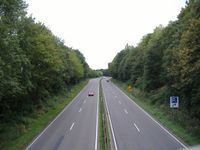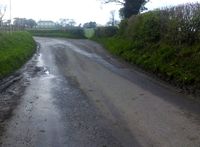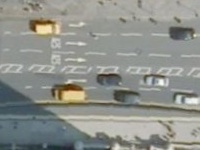Key:lanes: Difference between revisions
m (Layout) |
(clarification) |
||
| Line 12: | Line 12: | ||
==Description== |
==Description== |
||
| ⚫ | |||
| ⚫ | |||
| ⚫ | |||
* General purpose [[wikipedia:Lane|traffic lanes]] suitable for vehicles wider than a motorbike. |
|||
| ⚫ | |||
| ⚫ | |||
| ⚫ | |||
* Longer slip-roads, for example on motorways and other fast major roads. Turning lanes for minor roads are not normally included. See {{Key|turn}} for further details about tagging turning lanes. |
|||
And the following lanes should be excluded: |
|||
| ⚫ | |||
| ⚫ | |||
* Turning lanes can be counted. This usually would result in the need to split ways quite often. Therefore most mappers tend to ''not'' map them on minor roads and/or common junctions. But especially on motorways they can provide valuable information. Further details about turning lanes can be provided by the key {{Key|turn}}. |
|||
| ⚫ | |||
| ⚫ | |||
* Parking lanes. Consider using {{Key|parking:lane}} to provide further information. |
* Parking lanes. Consider using {{Key|parking:lane}} to provide further information. |
||
* Bicycle lanes. Use the tag {{Tag|cycleway|lane}} for those. |
* Bicycle lanes. Use the tag {{Tag|cycleway|lane}} for those. |
||
* Emergency |
* Emergency [[wikipedia:Shoulder (road) | shoulder lanes]]. See [[Shoulder|shoulder proposal]] for further details. |
||
Revision as of 19:21, 30 April 2012
| Description |
|---|
| Total number of traffic lanes available for motorised traffic. |
| Group: Properties |
| Used on these elements |
| Useful combination |
|
| See also |
|
| Status: de facto |
| Tools for this tag |
|
Description
The lanes=* key should be used to specify the total number of traffic lanes a road has which are available to motorised traffic wider than a motor cycle.
The following lanes should be included:
- General purpose traffic lanes suitable for vehicles wider than a motorbike.
- Bus lanes, that are reserved for public service vehicles (PSV), for example buses and taxis. Additionally to the total number of lanes, consider to tag the number of lanes for PSV with lanes:psv=*, lanes:bus=* and lanes:taxi=*.
- High-occupancy vehicle lanes (sometimes also called carpool lanes, commuter lanes, express lanes, transit lanes). In analogy with the transport modes from the key access=* they could be tagged using lanes:hov=*.
- Other lanes such as spitsstrooks in the Netherlands which are available to traffic at certain restricted times, for example during the rush hour.
- Longer slip-roads, for example on motorways and other fast major roads. Turning lanes for minor roads are not normally included. See turn=* for further details about tagging turning lanes.
And the following lanes should be excluded:
- Parking lanes. Consider using parking:lane=* to provide further information.
- Bicycle lanes. Use the tag cycleway=lane for those.
- Emergency shoulder lanes. See shoulder proposal for further details.
If the number of lanes changes it is necessary to split the OSM way. This should be done as soon as:
- a new lane has reached its full width, or
- a lane starts to disappear (usually a merge with another lane)
Remark for data consumers
Many ways have not yet been tagged with the total number of lanes at all points, but only with the number of through lanes of a longer section. Therefore, data consumers can mostly treat the lanes tag as a minimum rather than an exact number.
Extended tagging
Lanes in different directions
If the lanes on a two way road are not distributed evenly between the driving directions, the keys lanes:forward=* and lanes:backward=* can be used in addition to the lanes tag. The key lanes:forward=* hereby refers to lanes which direction is equal to the direction of the OSM way, and lanes:backward=* to the opposite direction.
For lanes, which allow traffic in both directions like e.g. passing and center turn lanes, there currently exists only the proposed suffix :both_ways which would allow the key lanes:both_ways.
See below for some examples of the usage of those keys.
Lanes reserved for specific vehicles
The number of lanes which are reserved for specific types of vehicles can be tagged by suffixing the key lanes with the transport mode from the key access=*, e.g. lanes:bus=1 for a single lane reserved for buses. If it is necessary to specify the direction of those lanes, add the suffix :forward or :backward like in the previous section, i.e. lanes:taxi:forward=1 refers to single lane reserved for taxis in the same direction as the OSM way.
Note: These lane counts can only be used for lanes, that are reserved for a specific type of vehicle and not for lanes that some vehicles are restricted to. If, for example, heavy-good vehicles are restricted to one lane, it is not possible to tag this with lanes:hgv=1, because this would be a completely different meaning than e.g. lanes:psv=1, which specifies the number of lanes, which are reserved for public service vehicles. Restrictions for vehicles can be tagged using the suffix lanes, e.g. hgv:lanes=no|no|yes would restrict heavy-good vehicles to the rightmost lane.
Narrow roads
There exist roads, which are two-way roads but so narrow, that vehicles must slow down to pass each other. Besides lanes=* it is strongly recommend in such a case to tag also the width of the carriageway using width=* (Note: do not mistake this with maxwidth). If the width varies a lot, the minimum width of the carriageway should be specified. If it is not possible or reasonable to determine the exact width, use an estimation and tag additionally source:width=estimated, e.g. as follows:
lanes=2 width=4 source:width=estimated
Sometimes on narrow roads passing places exists, which allow vehicles to pass each other (see examples). They can be tagged using highway=passing_place. The lanes-count is not affected by them.
Note: Some people prefer to tag narrow two-way roads with lanes=1.5. See the discussion on tagging. This tagging might not be processed correctly by data consumers. Also see the section Open Issues for this.
Examples
| Photo | Tags | Remarks |
|---|---|---|

|
lanes=2 | A residential road with two lanes. Consider additional tagging with parking:lane=*. |

|
lanes=2 Each direction individually |
A dual 2-lane highway represented by two ways (each with oneway=yes). |

|
lanes=2 width=4 source:width=estimated |
A narrow two-way road with an estimated width of four metres. |

|
lanes=1 | A road with one lane. The passing place should be tagged using highway=passing_place on a node. |

|
lanes=3 lanes:forward=1 lanes:backward=1 |
A road with three lanes, where the middle lane is a center turn lane. Using the proposed suffix :both_ways this could be reduced to lanes=3 and lanes:both_ways=1, because the number of lanes in forward and backward directions are then evenly distributed and need not to be tagged explicitly.
|

|
lanes=5 lanes:forward=3 lanes:backward=2 Assuming the OSM way runs from left to right |
A road with five lanes, whereas three lanes run in forward direction, i.e. in the same direction as the OSM way. The turning lanes should be tagged using turn=* on the way. |
Assumptions
If for a two way road only the total lane count is tagged and this number is even, it is assumed that the lanes are allocated evenly to both driving directions.
If no lane count is specified at all, a lane count might be assumed as follows:
| Tag(s) | Assumed lane-count two way |
Assumed lane-count one way |
Remark |
|---|---|---|---|
| highway=residential highway=tertiary highway=secondary highway=primary |
2 | 1 | If the actual number of lanes is equal to the given assumption, the lane count is usually not tagged. |
| highway=service highway=track highway=path |
1 | 1 | If the actual number of lanes is equal to the given assumption, the lane count is usually not tagged. |
| highway=motorway highway=trunk |
These should usually be mapped as two separate ways | 2 or more | The actual number of lanes should always be tagged. However the given assumptions might be helpful for data consumers. |
Open issues
- The number of emergency lanes/shoulders can not be specified right now, but there exists a proposal for those.
- For lanes running in both directions there currently exists only the proposed suffix :both_ways.
- Some people use
lanes=1.5on narrow, two-way roads. This is currently under discussion.
Displaying the number of lanes
- To view the number of lanes in JOSM, its routes plugin with the following layer in routes.xml can be used:
<layer name="lanes">
<route color="#FF00FF">
<pattern>
(((lanes=10 | lanes=9 | lanes=8 | lanes=7) -oneway=yes) | ((lanes=6 | lanes=5 | lanes=4) oneway=yes))
</pattern>
</route>
<route color="#FF0000">
<pattern>
((lanes=6 -oneway=yes) | (lanes=3 oneway=yes))
</pattern>
</route>
<route color="#FF3F00">
<pattern>
(lanes=5 -oneway=yes)
</pattern>
</route>
<route color="#FF7F00">
<pattern>
((lanes=4 -oneway=yes) | (lanes=2 oneway=yes))
</pattern>
</route>
<route color="#FFBF00">
<pattern>
(lanes=3 -oneway=yes)
</pattern>
</route>
<route color="#FFFF00">
<pattern>
(((lanes=2 | lanes=1) -oneway=yes) | (lanes=1 oneway=yes))
</pattern>
</route>
</layer>
Related tags
- width=* for tagging the width of the carriageway
- source:width=* for specifying the source of the width
- access=* for transport modes and additional access restrictions
- parking:lane=* for parking lanes
- turn=* for turning lanes
- highway=passing_place for passing places